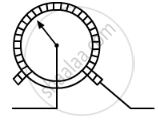Advertisements
Advertisements
प्रश्न
How does the resistance of a wire change when:
its material is changed to one whose resistivity is three times?
उत्तर
Resistance,
`R=l/A`
where l = length of wire
A= area of cross-section of the wire
When the material is changed to one whose resistivity is three times:
`R=(3rho)/A=3R`
APPEARS IN
संबंधित प्रश्न
What is (a) the highest, (b) the lowest total resistance that can be secured by combinations of four coils of resistance 4 Ω, 8 Ω, 12 Ω, 24 Ω?
Why are alloys commonly used in electrical heating devices? Give reason.
What is meant by conductors and insulators? Give two examples of conductors and two of insulators.
Which of the following are conductors and which are insulators?
Sulphur, Silver, Copper, Cotton, Aluminium, Air, Nichrome, Graphite, Paper, porcelain, Mercury, Mica, Bakelite, Polythene, Manganin.
Which has less electrical resistance : a thin wire or a thick wire (of the same length and same material)?
What happens to the resistance as the conductor is made thicker?
How does the resistance of a conductor depend on:
area of cross-section of the conductor?
How does the resistance of a conductor depend on:
temperature of the conductor?
The figure blow shows a variable resistor in a dimmer switch.

How would you turn the switch to make the lights: (a) brighter, and (b) dimmer? Explain your answer.
How will the resistance of a wire be affected if its
- length is doubled, and
- radius is also doubled ?
Give justification for your answer.
